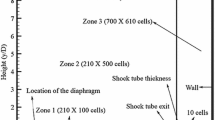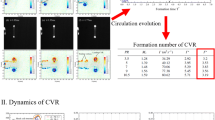Abstract
The oblique collision of a vortex ring with a solid wall, atRe=Γ/ν=1389, has been analysed by the direct simulation of the Navier-Stokes equations in Cartesian coordinates. In accordance with a previous experimental study [1], the secondary vorticity produced at the wall is organized into a loop-like vortex in the region of the ring furthest away from the wall. As the ring approaches the wall, the region closest is subjected to a high rate of stretching which increases the vorticity in the core. The vorticity gradients along the core generate bi-helical vortex lines continually displaced towards the region of the ring furthest away from the wall. The analysis of the vorticity and straining fields revealed that the pressure gradient along the core is responsible for the convective motion that displaces these vortex lines and accumulates secondary vorticity in the region far from the wall. This vorticity rolls up and forms a secondary structure which by self-induction moves away from the wall.
The fundamental role of the differential stretching has been demonstrated by comparing the case of oblique collision with that of normal collision and with the collision of a two-dimensional vortex pair with an oblique wall.
Sommario
L'interazione di un vortice ad anello con una parete obliqua, aRe=1389, è stata analizzata mediante la simulazione diretta delle equazioni di Navier-Stokes in coordinate cartesiane. In accordo con un precedente esperimento [1] è stato evidenziato che la vorticità secondaria, prodotta alla parete, si organizza in una strutura vorticosa a ‘loop’ nella regione dell'anello più lontana dalla parete. Quando il vortice si avvicina alla parete, la parte più vicina è soggetta ad un'elevata deformazione che aumenta il valore della vorticità nel ‘core’. La distribuzione non uniforme di vorticità lungo il ‘core’ del vortice genera delle linee di vorticità elicoidali che vengono transportate verso la regione dell'anello più lontana dalla parete. L'analisi dei campi di vorticità e di deformazione ha rivelato che il gradiente di pressione, dovuto al campo di deformazione non uniforme lungo il ‘core’ del vortice, è responsabile di un moto convettivo che trasporta le linee di vorticità ed accumula la vorticità secondaria nella regione del vortice più lontana dalla parete, dove la struttura secondaria viene generata.
Il ruolo fondamentale della deformazione non uniforme è stato evidenziato mediante il confronto della collisione obliqua coni casi di collisione normale e di collisione di una coppia di vortici bidimensionali con una parete obliqua.
Similar content being viewed by others
References
Lim, T.T., ‘An experimental study of a vortex ring interacting with an inclined wall’,Exp. in Fluids 6 (1989), 453–463.
Chu C.C and Falco R.E., ‘Vortex ring/viscous wall layer interaction model of the turbulence production process near walls’,Exp. in Fluids 6 (1988), 305–325.
Walker, J.D.A., Smith, C.R., Cerra, A.W., and Doligaski, J.L., ‘The impact of a vortex ring on a wall’,J. Fluid Mech 181 (1987) 99–140.
Orlandi, P., and Verzicco, R., ‘Vortex ring impinging on a wall: axisymmetric and three-dimensional simulations’,J. Fluid Mech 256 (1993) 615–645.
Lugt, H.J., and Horing, S., ‘The oblique rise of a viscous vortex ring toward a deformable free surface’. To appear inMeccanica (1994).
Verzicco, R., and Orlandi, P., ‘A finite-difference scheme for three-dimensional flows in cylindrical coordinates’, submitted toJ. Comp. Phys. (1993).
Kim, J., and Moin, P., ‘Application of a fractional-step method to incompressible Navier-Stokes equations’,J. Comp. Phys. 59 (1985) 308–323.
Rai, M.M., and Moin, P., ‘Direct simulations of turbulent flow using finite-difference schemes’,J. Comp. Phys. 96 (1991) 15–53.
Sullivan, J.P., Widnall, S.E. and Ezekiel, S., ‘Study of vortex rings using a laser doppler velocimeter’,AIAA J. 11 (1973) 1384–1389.
Author information
Authors and Affiliations
Rights and permissions
About this article
Cite this article
Verzicco, R., Orlandi, P. Normal and oblique collisions of a vortex ring with a wall. Meccanica 29, 383–391 (1994). https://doi.org/10.1007/BF00987573
Received:
Accepted:
Issue Date:
DOI: https://doi.org/10.1007/BF00987573




